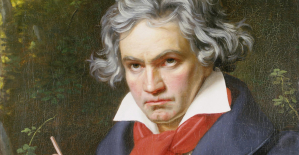Which discoveries, insights or inventions were the most important at the end of 2022? The publishers and editors of the renowned journal "Science" have thought about this and named the James Webb Space Telescope "Breakthrough" of the year, i.e. the biggest scientific breakthrough of 2022.
The superlative telescope has only been in operation for around six months. During this time, it has already provided many breathtaking images of cosmic objects and important new insights.
The ten billion dollar James Webb Telescope looks into space with its 6.50 meter main mirror in the range of infrared light waves. This enables insights that are not possible with optical telescopes like "Hubble" - for example the exploration of regions hidden behind clouds of dust.
The European Space Agency Esa, which is involved in the "James Webb program", also chose a picture supplied by the space telescope as the picture of the year. It is the image of the galaxy cluster SMACS 0723, 4.6 billion light-years away. It impresses even laypeople with its overwhelming wealth of details.
James Webb's infrared image of SMACS 0723 is the deepest and sharpest view of the universe ever seen with a telescope. Thousands of galaxies are recorded there. It's also a glimpse into the past, as the light caught by James Webb traveled 4.6 billion years. The spectacular image was presented to the world public on July 11, 2022 - during a Webb premieres event that was broadcast from the White House in Washington.
Since then, scientists have continuously published new findings that they gained with the help of "James Webb". It's about dust clouds in which new stars are born, old galaxies, the analysis of the atmosphere of distant exoplanets or the exploration of the planets in our solar system. With a spectral analysis, the infrared telescope was able to prove the existence of carbon dioxide in the gas envelope of an exoplanet for the first time.
It was only in mid-December that researchers published new findings on the star cluster NGC 3324 in the "Monthly Notices of the Royal Astronomical Society", which they owe to "James Webb". In the infrared image, they could make out dozens of high-energy jets ejected from young stars. "Hubble" had already looked at this region of the so-called "Cosmic Cliffs" because the astronomers suspected a birthplace for stars there.
Hubble, however, was denied a glimpse into the cosmic delivery room because its visible-light eyes cannot see through a cloud of dust. James Webb's infrared cameras are capable of this. By observing such regions of star birth, the scientists hope to gain new insights into how sun-like stars are formed and how radiation from neighboring stars may influence planet formation.
In recent years, it has not been discoveries from astronomy that have been proclaimed scientific breakthrough of the year by the "Science" editorial team. In 2021, that honor went to decoding the protein code using artificial intelligence. And in 2020, the most important thing was the development of new vaccines against the coronavirus.

 Israel-Hamas war: Gaza between hope of truce and fear of Israeli offensive in the South
Israel-Hamas war: Gaza between hope of truce and fear of Israeli offensive in the South “Mom, Dad, please don’t die”: in the United States, a nine-year-old child saves the lives of his parents injured in a tornado
“Mom, Dad, please don’t die”: in the United States, a nine-year-old child saves the lives of his parents injured in a tornado War in Ukraine: Putin orders nuclear exercises in response to Macron and “Western leaders”
War in Ukraine: Putin orders nuclear exercises in response to Macron and “Western leaders” Mexico: the last moments of surfers found in a well, killed with a bullet to the head
Mexico: the last moments of surfers found in a well, killed with a bullet to the head A baby whose mother smoked during pregnancy will age more quickly
A baby whose mother smoked during pregnancy will age more quickly The euro zone economy grows in April at its best pace in almost a year but inflationary pressure increases
The euro zone economy grows in April at its best pace in almost a year but inflationary pressure increases Children born thanks to PMA do not have more cancers than others
Children born thanks to PMA do not have more cancers than others Breast cancer: less than one in two French women follow screening recommendations
Breast cancer: less than one in two French women follow screening recommendations “A potential environmental disaster”: Paris town hall opposes an oil drilling project in Seine-et-Marne
“A potential environmental disaster”: Paris town hall opposes an oil drilling project in Seine-et-Marne The governor of the Banque de France pleads for the development of French and European AI
The governor of the Banque de France pleads for the development of French and European AI Clariane (ex-Korian) announces a sale of its home hospitalization activities
Clariane (ex-Korian) announces a sale of its home hospitalization activities To everyone's surprise, the Hades 2 event video game is released in early access
To everyone's surprise, the Hades 2 event video game is released in early access The Origin of the World, exhibited at the Center Pompidou Metz, target of an “artistic performance”
The Origin of the World, exhibited at the Center Pompidou Metz, target of an “artistic performance” Threatened with death for having insulted the mobilized pro-Palestinian students, Élie Semoun files a complaint
Threatened with death for having insulted the mobilized pro-Palestinian students, Élie Semoun files a complaint Vienna, Paris, Milan celebrate the 200th anniversary of Beethoven's 9th Symphony
Vienna, Paris, Milan celebrate the 200th anniversary of Beethoven's 9th Symphony Cannes Film Festival: call for strike one week before opening
Cannes Film Festival: call for strike one week before opening Omoda 7, another Chinese car that could be manufactured in Spain
Omoda 7, another Chinese car that could be manufactured in Spain BYD chooses CA Auto Bank as financial partner in Spain
BYD chooses CA Auto Bank as financial partner in Spain Tesla and Baidu sign key agreement to boost development of autonomous driving
Tesla and Baidu sign key agreement to boost development of autonomous driving Skoda Kodiaq 2024: a 'beast' plug-in hybrid SUV
Skoda Kodiaq 2024: a 'beast' plug-in hybrid SUV The home mortgage firm rises 3.8% in February and the average interest moderates to 3.33%
The home mortgage firm rises 3.8% in February and the average interest moderates to 3.33% This is how housing prices have changed in Spain in the last decade
This is how housing prices have changed in Spain in the last decade The home mortgage firm drops 10% in January and interest soars to 3.46%
The home mortgage firm drops 10% in January and interest soars to 3.46% The jewel of the Rocío de Nagüeles urbanization: a dream villa in Marbella
The jewel of the Rocío de Nagüeles urbanization: a dream villa in Marbella Europeans: David Lisnard expresses his “essential and vital” support for François-Xavier Bellamy
Europeans: David Lisnard expresses his “essential and vital” support for François-Xavier Bellamy Facing Jordan Bardella, the popularity match turns to Gabriel Attal’s advantage
Facing Jordan Bardella, the popularity match turns to Gabriel Attal’s advantage Europeans: a senior official on the National Rally list
Europeans: a senior official on the National Rally list Blockade of Sciences Po: the right denounces a “drift”, the government charges the rebels
Blockade of Sciences Po: the right denounces a “drift”, the government charges the rebels These French cities that will boycott the World Cup in Qatar
These French cities that will boycott the World Cup in Qatar Foot: Italian football protests against a government project which aims to monitor club finances
Foot: Italian football protests against a government project which aims to monitor club finances Champions League: “We are ready for anything,” warns Edin Terzic before PSG-Dortmund
Champions League: “We are ready for anything,” warns Edin Terzic before PSG-Dortmund Premier League: David Moyes to leave West Ham at end of season
Premier League: David Moyes to leave West Ham at end of season Transat CIC: Yoann Richomme winner in the wake of Tabarly, Poupon, Peyron, Desjoyeaux...
Transat CIC: Yoann Richomme winner in the wake of Tabarly, Poupon, Peyron, Desjoyeaux...


















